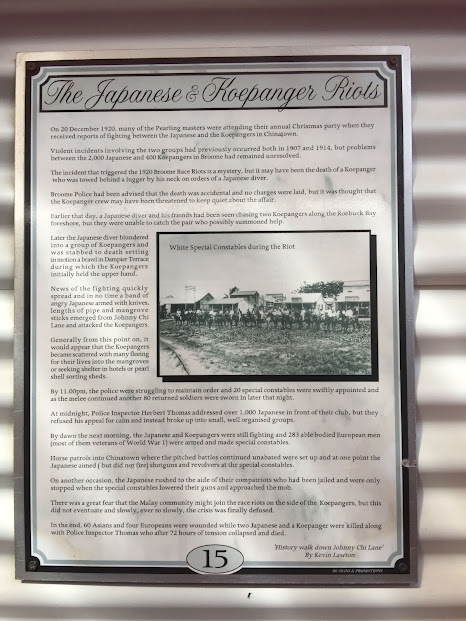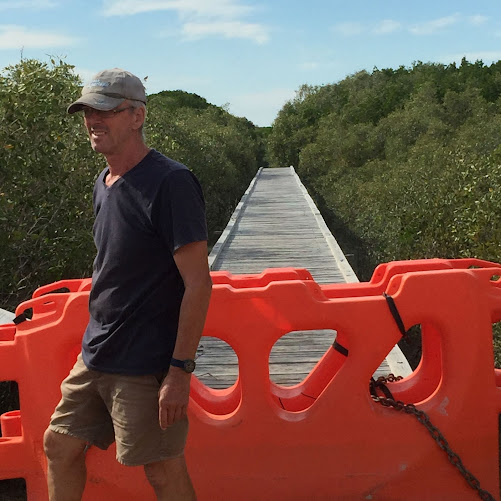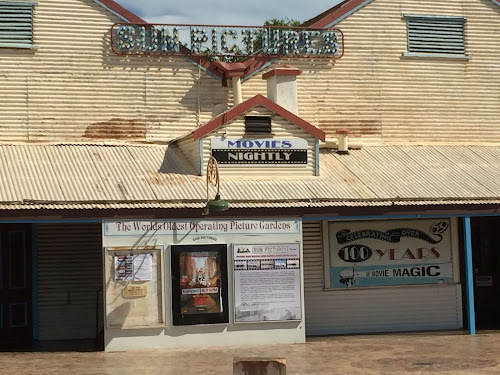Broome is one of the iconic places to visit in Western Australia and was definitely on our list, even if it was only going to be for a day. The caravan parks charge so much. The cheapest was $60 and then and extra $20 for Jonnie! Really! So we were lucky to have a 'friend who has a friend' with an area for caravans, and at $35 per night, power and water included, we rang and we were welcomed. We don’t need jumping castles or swimming pools, or even power (but it’s nice). Anyway, it was close to town and perfectly safe to leave the van so we can do day trips.
Broome would not be here if it wasn't for the Pearling industry. In 1688 and again in 1699, British explorer and former pirate William Dampier noted in his journals the presence of pearl shell along the coast. It was originally a few shanties servicing the pearl luggers that
frequented the 15km long peninsula. It was gazetted in 1883, and named after the then Governor of Western Australia, Sir Frederick Broome. It quickly
became a multi-cultural mix of peoples and the legacy, history and
culture of these early inhabitant can still be seen today, especially in the
Chinatown area. Located on Dampier Terrace, one of the two main streets of the old town, is the Memorial to the Hard-hat Divers of Broome, a sculpture by Joan Walsh Smith and Charles Smith.
We started each day early, as the temperatures would rise quickly to the mid-high 30's, and then we would go back to the comfort of the air-conditioned van around lunch time to relax. A walk down Johnny Chi Lane is interesting and the coffee shop is great, and there are just so many things to see in the old part of town, known as Chinatown. The Chinese were a minority group in the town, but they continually maintained a presence through out the town's history. Originally bought to Western Australia as Chinese labour for the agricultural and pastoral stations, many broke their contracts and fleed to the towns where they worked until they were caught and returned to Singapore. Those that did stay until the end of their contracts headed to the gold fields or set up work in the pearling towns. Many set up camps around Shark Bay leading the European pearlers to restrict the Chinese pearlers with the Shark Bay Pearl Fishery Act of 1886. The port of Broome was where these Chinese headed and took up work as cooks, gardeners, and domestic workers in hotels and private houses. Johnny Chi was the only registered Chinese pearler and became a distinguished member of the Broome Chinese Community.
Born in the early 1850's in Swatow, China, Johnny came to Australia to try his luck at the Ballarat Goldfields. He arrived in Western Australia July 1872, and became naturalised later that same year and moved to Broome. He owned two pearling luggers and a retail business and the management of a boarding house. During his career he owned a famous restaurant and kitchen in what is now known as Johnny Chi Lane.
Many buildings and streets have information boards telling stories of the past.
On Dampier Terrace there are many pearl and jewellery shops.
One, Willie Creek Pearls offers tours from their showroom and has a replica pearling lugger in their courtyard.
One is transported by bus to the farm for a tour. We drove a there few days later to have a look.
Further down the road, at Cygnet Bay Pearls Shop there is a great free display of history and the pearling industry. Well worth a visit.
On show in the showroom is the worlds largest pearl, the Australia Pearl – 22.24mm. Tours can also be booked there.
At the bottom of Dampier Terrace is Streeter Jetty. It was being renovated and was closed to tourists while we were there.
Streeter Jetty was the main wharf that the Broome community used for many reasons. Built in the 1890's by E.W. Streeter it became one of the main entry points to town.
At the other end of Dampier Terrace is the Roebuck Bay Lookout, with 180 degrees views over Roebuck Bay and Dampier Creek.
At midday the sun makes a beautiful shadow of the laser cut roof, of course we planned our day around ending here at the lookout to see the shadows.
Running parallel to Dampier Terrace, Carnarvon Street is the other main road in the old town. The street is very Chinese/Asian in theme.
Sculptures and decorations adorn many of the buildings.
Sun Pictures, the oldest operating picture garden in the world, was designed with the tropics in mind. Constructed in 1903, it originally served as an Asian emporium selling food and goods to the largely Asian community. The owners, the Yamasaki Family loved the theatre, so set aside part of the emporium to perform traditional Japanese Noh theatre. Pearler Ted Hunter purchased the building in 1913 and commissioned architect Claude Hawkes to design a picture theatre that would hold up to 500 people. The first movie shown was 'Kissing Cup', a silent movie in 1916. The first talking movie was 1933, 'Monte Carlo'. Interesting, the theatre was subject to tidal flooding and some said you could go fishing while watching a movie. A levee bank was built in 1974 to stop the tides. Sun Pictures was put on the Register of the National Estate in 1989, and in 1995 on the Western Australian State Register of Heritage Places. Tours operate June to August.
Very interesting two streets, telling the history of early Broome.
Plenty of shops cafes, restaurants, hotels, and tours.
Even the local Coles shopping centre has art work depicting the pearling life.
Cable Beach is what one knows about Broome, and it is beautiful. We explored the rock pools at low tide on Cable beach while waiting to see the camels.
One end up past the Resort is a nudest area, although we parked on the sand in front of the resort and there were a couple of very tanned naked men walking up from the ocean to the resort.
Cable Beach was named after the telegraph cable laid between Broome and Java in 1889. The road down to the beach is only available at low tide and one drives through and around the rock pools.
Driving from Cable Beach down along the ocean side of the peninsula we came to Gantheaume Point. Accessible at low tide, the red cliffs make a good contract with the white sans and sparkling aquamarine water. We had lunch there one day and it was just glorious.
There are thousands of dinosaur footprints in the Broome area. Over 21 different types of dinosaur footprints have been found and are believed to be older than those found in the eastern states. We didn't see any dinosaur footprints because we were never at the right place at the ride time of the tide.
Gantheaume Point was named in 1801 by Frenchman Nicolas Baudin after the French
Naval Admiral, Joseph Gantheaume. The first lighthouse was built in 1906 and consisted of 47ft lighthouse and a four room keepers cottage. A new lighthouse was built in 1917. The second lighthouse remained until 1984, when it was replaced with a stainless steel tower and electric light. The keepers house burnt down about 1970, leaving only the stone fireplace.
An interesting story about Gantheaume Point can be found here.
Following the coast road around from Gantheaume Point we came to the Port of Broome. There was a restaurant there we had heard about at the Fishing Club, but it was closed, a cshame because the menu looked good. In 1889, 5 years after the township of Broome was gazetted, a port opened as a Warehousing Port. The present port at the entrance of Roebuck Bay, known as Entrance Point, was begun in February 1964 and officially opened in July 1966.
Broome is one of the many places to see Staircase
to the Moon, due about two weeks from when we visited. We also visited the Japanese / Chinese Cemetery. The first recorded burial in this cemetery was in 1896. There are 919 people buried here, many deaths from cyclones, and divers in the pearling industry.
As I said above, tours are available from Broome at a cost of $125 per person via coach, or $75 per person self drive. The tour would have been great, but a bit expensive for us ($225 total) and we were travelling on a budget. The tour included a boat ride, a visit to the hatchery, home made damper and tea, and a discount in the gift shop.
Willie Creek Pearl Farm is family owned and operated by the Banfield family and the farm is certainly a tourist attraction. As well as the hatchery there are interactive activities.
We were met by a lovely young lady as we were sanitizing and checking in who told us about the tours and cafe.
We had a walk around the small house and shop area, thought about having some scones, but a tour had just arrived so it was fairly busy. The water is aquamarine blue and absolutely beautiful.
Something we didn't know, the town of Broome was attacked by the Japanese on 3 March 1942, during World War II. Following the invasion of Java by the Japanese, many Dutch and other refugees arrived in Broome.
There are lots of tours and activities from whale watching and camel rides to deep sea fishing. We did what we wanted to do, and although it would have been good to stay longer and just relax on the beach, we headed off after 5 days. Very glad we visited Broome.
Watch Peter's PetalliTravellers Youtube Channel about Willie Creek. Sadly his back up drive failed and most of our Broome Trip disappeared in the never never.






































No comments:
Post a Comment